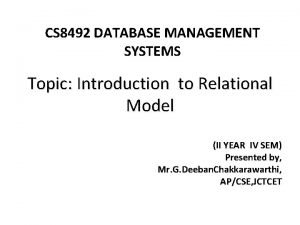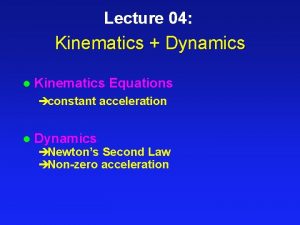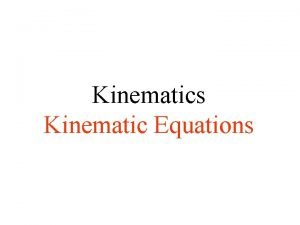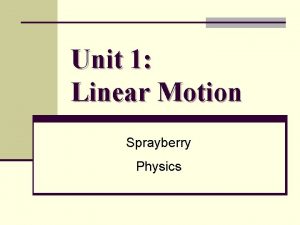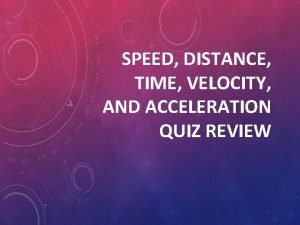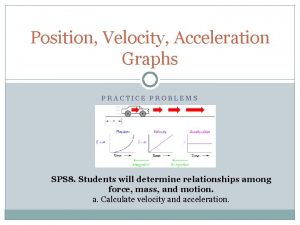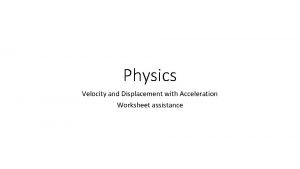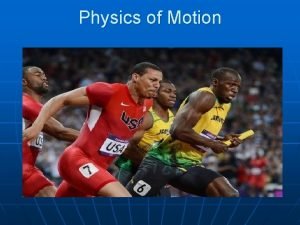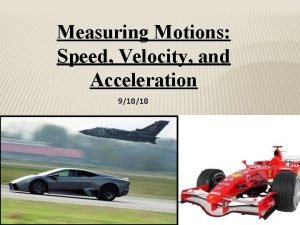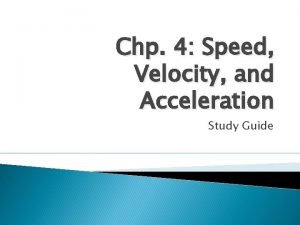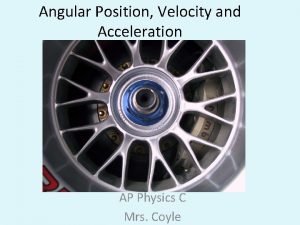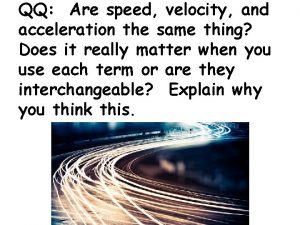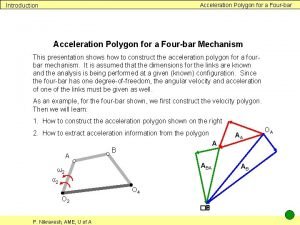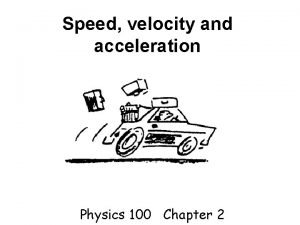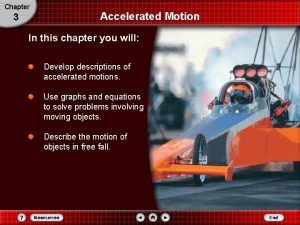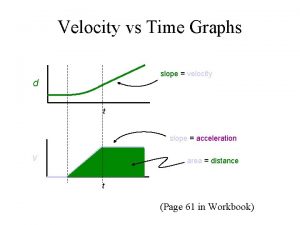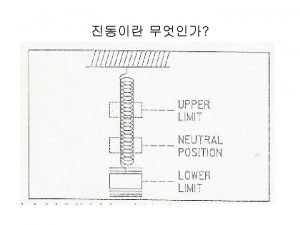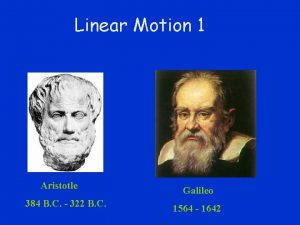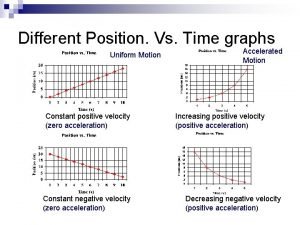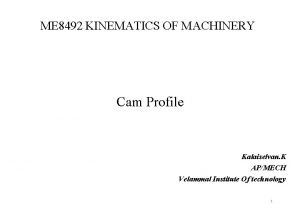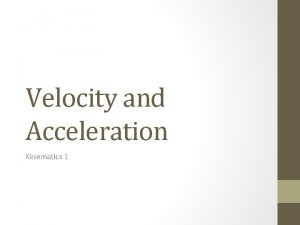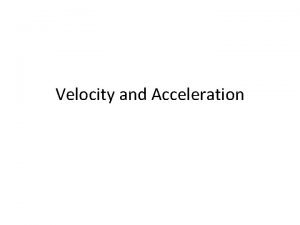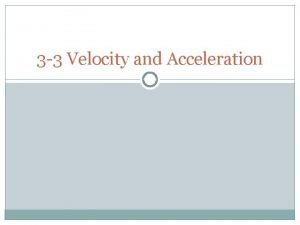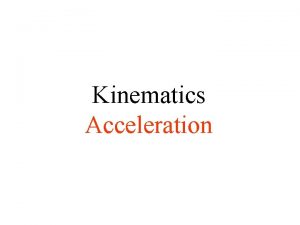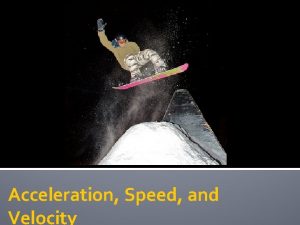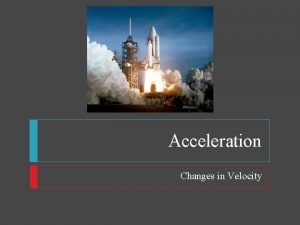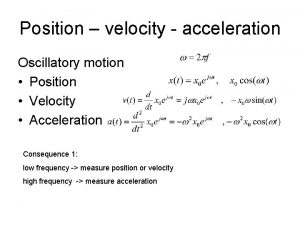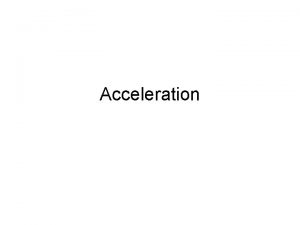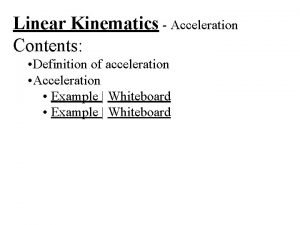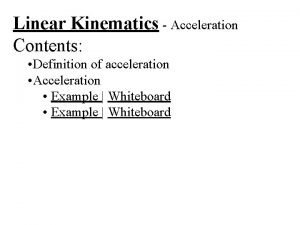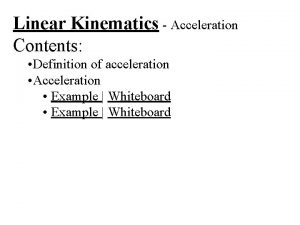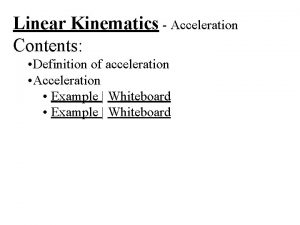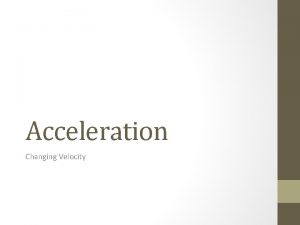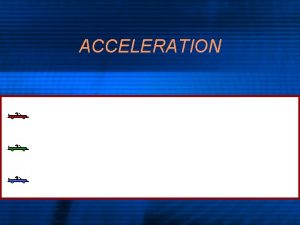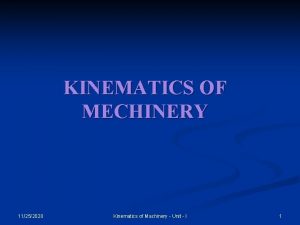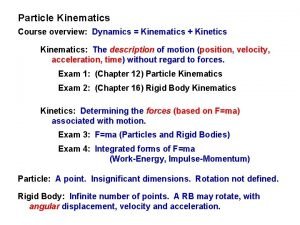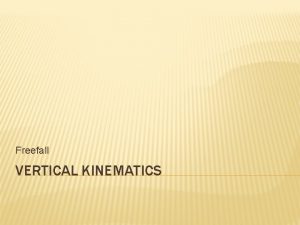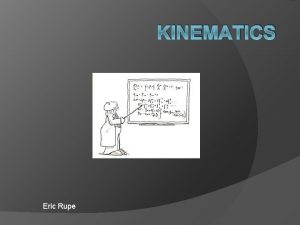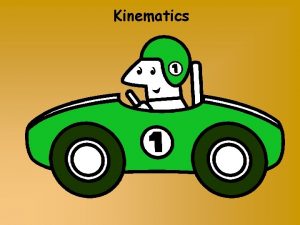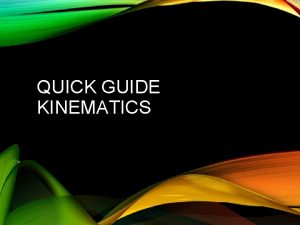ME 8492 KINEMATICS OF MACHINERY Velocity and Acceleration








































- Slides: 40

ME 8492 KINEMATICS OF MACHINERY Velocity and Acceleration Diagram Kalaiselvan. K AP/MECH Velammal Institute Of technology 1

Relative Velocity of Two Bodies Moving in Straight Lines • Here we shall discuss the application of vectors for the relative velocity of two bodies moving along parallel lines and inclined lines, as shown in Fig. • Consider two bodies A and B moving along parallel lines in the same direction with absolute velocities v. A and v. B such that v. A > v. B , as shown in Fig. (a). The relative velocity of A with respect to B is ……. 3/10/2016 Hareesha N G, Dept of Aero Engg, DSCE, Blore 2

• Now consider the body B moving in an inclined direction as shown in Fig. 2 (a). The relative velocity of A with respect to B may be obtained by the law of parallelogram of velocities or triangle law of velocities. • Take any fixed point o and draw vector oa to represent v. A in magnitude and direction to some suitable scale. • Similarly, draw vector ob to represent v. B in magnitude and direction to the same scale. Then vector ba represents the relative velocity of A with respect to B as shown in Fig. 2 (b). In the similar way as discussed above, the relative velocity of A with respect to B, 3/10/2016 Hareesha N G, Dept of Aero Engg, DSCE, Blore 3

• Consider two points A and B on a rigid link AB as shown in Fig. • Let one of the extremities (B) of the link move relative to A, in a clockwise direction. • Since the distance from A to B remains the same, therefore there can be no relative motion between A and B, along the line AB. • It is thus obvious, that the relative motion of B with respect to A must be perpendicular to AB. • Hence velocity of any point on a link with respect to another point on the same link is always perpendicular to the line joining these points on the configuration (or space) diagram. 3/10/2016 Hareesha N G, Dept of Aero Engg, DSCE, Blore 4

• • The relative velocity method is based upon the relative velocity of the various points of the link. Consider two points A and B on a link as shown in Fig. 4 (a). Let the absolute velocity of the point A i. e. v. A is known in magnitude and direction and the absolute velocity of the point B i. e. v. B is known in direction only. Then the velocity of B may be determined by drawing the velocity diagram as shown in Fig. 4 (b). The velocity diagram is drawn as follows : b VBA VB 3/10/2016 Hareesha N G, Dept of Aero Engg, DSCE, Blore o VA a 5

b c VBA VB 3/10/2016 Hareesha N G, Dept of Aero Engg, DSCE, Blore o VA a 6

Rubbing Velocity at pin joint 3/10/2016 Hareesha N G, Dept of Aero Engg, DSCE, Blore 7

Acceleration Diagram for a Link • Consider two points A and B on a rigid link as shown in Fig. (a). • Let the point B moves with respect to A, with an angular velocity of ω rad/s and let α rad/s 2 be the angular acceleration of the link AB. • Acceleration of a particle whose velocity changes both in magnitude and direction at any instant has the following two components : 1. The centripetal or radial component, which is perpendicular to the velocity of the 2. particle at the given instant. The tangential component, which is parallel to the velocity of the particle at the given instant. • Thus for a link AB, the velocity of point B with respect to A (i. e. v. BA) is perpendicular to the link AB as shown in Fig. 8. 1 (a). Since the point B moves with respect to A with an angular velocity of ω rad/s, therefore centripetal or radial component of the acceleration of B with respect to A, This radial component of acceleration acts perpendicular to the velocity v. BA, In other words, it acts parallel to the link AB. 3/10/2016 Hareesha N G, Dept of Aero Engg, DSCE, Blore 8

3/10/2016 Hareesha N G, Dept of Aero Engg, DSCE, Blore 9

Acceleration of a Point on a Link • Consider two points A and B on the rigid link, as shown in Fig. (a). Let the acceleration of the point A i. e. a. A is known in magnitude and direction and the direction of path of B is given. • The acceleration of the point B is determined in magnitude and direction by drawing the acceleration diagram as discussed below. 1. From any point o', draw vector o'a' parallel to the direction of absolute acceleration at point A i. e. a. A , to some suitable scale, as shown in Fig. (b). o' 3/10/2016 Hareesha N G, Dept of Aero Engg, DSCE, Blore a' 10

2. We know that the acceleration of B with respect to A i. e. a. BA has the following two components: (i) Radial component of the acceleration of B with respect to A i. e. ar , and BA (ii) Tangential component of the acceleration B with respect to A i. e. at BA These two components are mutually perpendicular. 3. Draw vector a'x parallel to the link AB (because radial component of the acceleration of B with respect to A will pass through AB), such that o' 3/10/2016 Hareesha N G, Dept of Aero Engg, DSCE, Blore a' x 11

5. By joining the points a' and b' we may determine the total acceleration of B with respect to A i. e. a. BA. The vector a' b' is known as acceleration image of the link AB. 6. The angular acceleration of the link AB is obtained by dividing the tangential b' components of the acceleration of B a. BA with respect to A (at. BA ) to the length a. B of the link. o' Mathematically, angular acceleration of the a' link AB, at. BA ar. BA 3/10/2016 Hareesha N G, Dept of Aero Engg, DSCE, Blore x 12

1. First of all draw the space diagram, to some suitable scale; as shown in Fig. (a). 3/10/2016 Hareesha N G, Dept of Aero Engg, DSCE, Blore 13

To Draw Velocity Vector polygon 1. Draw vector ob perpendicular to BO, to some suitable scale, to represent the velocity of B with respect to O or simply velocity of B i. e. v. BO or v. B, such that vector ob = v. BO = v. B = 4. 713 m/s 2. From point b, draw vector ba perpendicular to BA to represent the velocity of A with respect to B i. e. v. AB , and from point o draw vector oa parallel to the motion of A (which is along AO) to represent the velocity of A i. e. v. A. The vectors ba and oa intersect at a. 3. By measurement, we find that velocity of A with respect to B, b v. B o 3/10/2016 v. AB v. A a Hareesha N G, Dept of Aero Engg, DSCE, Blore 14

4. In order to find the velocity of the midpoint D of the connecting rod AB, divide the vector ba at d in the same ratio as D divides AB, in the space diagram. In other words, bd / ba = BD/BA Note: Since D is the midpoint of AB, therefore d is also midpoint of vector ba. 5. Join od. Now the vector od represents the velocity of the midpoint D of the connecting rod i. e. v. D. By measurement, we find that v. D = vector od = 4. 1 m/s b v. B v. D o 3/10/2016 v. A d v. AB a Hareesha N G, Dept of Aero Engg, DSCE, Blore 15

Acceleration of the midpoint of the connecting rod • We know that the radial component of the acceleration of B with respect to O or the acceleration of B, and the radial component of the acceleration of A with respect to B, NOTE: 1) A point at the end of a link which moves with constant angular velocity has no tangential component of acceleration. 2) When a point moves along a straight line, it has no centripetal or radial component of the acceleration. 3/10/2016 Hareesha N G, Dept of Aero Engg, DSCE, Blore 16

Acceleration of the midpoint of the connecting rod 3/10/2016 Hareesha N G, Dept of Aero Engg, DSCE, Blore 17

3/10/2016 Hareesha N G, Dept of Aero Engg, DSCE, Blore 18

3/10/2016 Hareesha N G, Dept of Aero Engg, DSCE, Blore 19

3/10/2016 Hareesha N G, Dept of Aero Engg, DSCE, Blore 20

3/10/2016 Hareesha N G, Dept of Aero Engg, DSCE, Blore 21

3/10/2016 Hareesha N G, Dept of Aero Engg, DSCE, Blore 22

3/10/2016 Hareesha N G, Dept of Aero Engg, DSCE, Blore 23

3/10/2016 Hareesha N G, Dept of Aero Engg, DSCE, Blore 24

In the mechanism, as shown in Fig. , the crank OA rotates at 20 r. p. m. anticlockwise and gives motion to the sliding blocks B and D. The dimensions of the various links are OA = 300 mm; AB = 1200 mm; BC = 450 mm and CD = 450 mm. For the given configuration, determine : 1. velocities of sliding at B and D, 2. angular velocity of CD, 3. linear acceleration of D and 4. angular acceleration of CD. 3/10/2016 Hareesha N G, Dept of Aero Engg, DSCE, Blore 26

3/10/2016 Hareesha N G, Dept of Aero Engg, DSCE, Blore 27

3/10/2016 Hareesha N G, Dept of Aero Engg, DSCE, Blore 28

3/10/2016 Hareesha N G, Dept of Aero Engg, DSCE, Blore 29

3/10/2016 Hareesha N G, Dept of Aero Engg, DSCE, Blore 30

3/10/2016 Hareesha N G, Dept of Aero Engg, DSCE, Blore 30

3/10/2016 Hareesha N G, Dept of Aero Engg, DSCE, Blore 31

In the toggle mechanism shown in Fig. , the slider D is constrained to move on a horizontal path. The crank OA is rotating in the counter-clockwise direction at a Speed of 180 r. p. m. increasing at the rate of 50 rad/s 2. The dimensions of the various links are as follows: OA = 180 mm ; CB = 240 mm ; AB = 360 mm ; and BD = 540 mm. For the given configuration, find 1. Velocity of slider D and angular velocity of BD, and 2. Acceleration of slider D and angular acceleration of BD. 3/10/2016 Hareesha N G, Dept of Aero Engg, DSCE, Blore 32

1. Velocity of slider D and angular velocity of BD First of all, draw the space diagram to some suitable scale, as shown in Fig. (a). Now the velocity diagram, as shown in Fig. (b), is drawn as discussed below: 3/10/2016 Hareesha N G, Dept of Aero Engg, DSCE, Blore 34

3/10/2016 Hareesha N G, Dept of Aero Engg, DSCE, Blore 34

3/10/2016 Hareesha N G, Dept of Aero Engg, DSCE, Blore 35

3/10/2016 Hareesha N G, Dept of Aero Engg, DSCE, Blore 36

3/10/2016 Hareesha N G, Dept of Aero Engg, DSCE, Blore 37

3/10/2016 Hareesha N G, Dept of Aero Engg, DSCE, Blore 38

3/10/2016 Hareesha N G, Dept of Aero Engg, DSCE, Blore 39

3/10/2016 Hareesha N G, Dept of Aero Engg, DSCE, Blore 40
 Cs 8492
Cs 8492 Final velocity initial velocity acceleration time
Final velocity initial velocity acceleration time Deceleration formula
Deceleration formula Aplusphysics kinematics-horizontal kinematics
Aplusphysics kinematics-horizontal kinematics Kinematic equaitons
Kinematic equaitons Kinematic equations
Kinematic equations Coriolis acceleration
Coriolis acceleration Jacobian singularity
Jacobian singularity Linear to angular velocity
Linear to angular velocity Linear acceleration
Linear acceleration Centripetal acceleration tangential acceleration
Centripetal acceleration tangential acceleration What is the difference between velocity and acceleration
What is the difference between velocity and acceleration Velocity
Velocity Velocity=distance/time
Velocity=distance/time Speed velocity and acceleration problems answers
Speed velocity and acceleration problems answers Relative velocity and acceleration
Relative velocity and acceleration Position velocity acceleration
Position velocity acceleration Displacement and velocity worksheet
Displacement and velocity worksheet Difference between velocity and acceleration
Difference between velocity and acceleration What is the difference between speed and velocity
What is the difference between speed and velocity A cart slows down while moving away from the origin
A cart slows down while moving away from the origin Apewlklar-u -site:youtube.com
Apewlklar-u -site:youtube.com Speed velocity and acceleration study guide answers
Speed velocity and acceleration study guide answers Angular acceleration unit
Angular acceleration unit Velocity polygon
Velocity polygon Describes both speed and direction
Describes both speed and direction Are speed velocity and acceleration the same thing
Are speed velocity and acceleration the same thing Reference point examples
Reference point examples Velocity and acceleration quick check
Velocity and acceleration quick check What polygon is this
What polygon is this Velocity and speed
Velocity and speed Acceleration
Acceleration Chapter 3 accelerated motion practice problems answers
Chapter 3 accelerated motion practice problems answers Centripetal acceleration is
Centripetal acceleration is Is radial acceleration the same as centripetal acceleration
Is radial acceleration the same as centripetal acceleration Initial velocity and final velocity formula
Initial velocity and final velocity formula Area under velocity time graph
Area under velocity time graph Derivatives of position
Derivatives of position Vibration displacement velocity acceleration
Vibration displacement velocity acceleration Negative velocity negative acceleration
Negative velocity negative acceleration Constant rightward velocity
Constant rightward velocity
